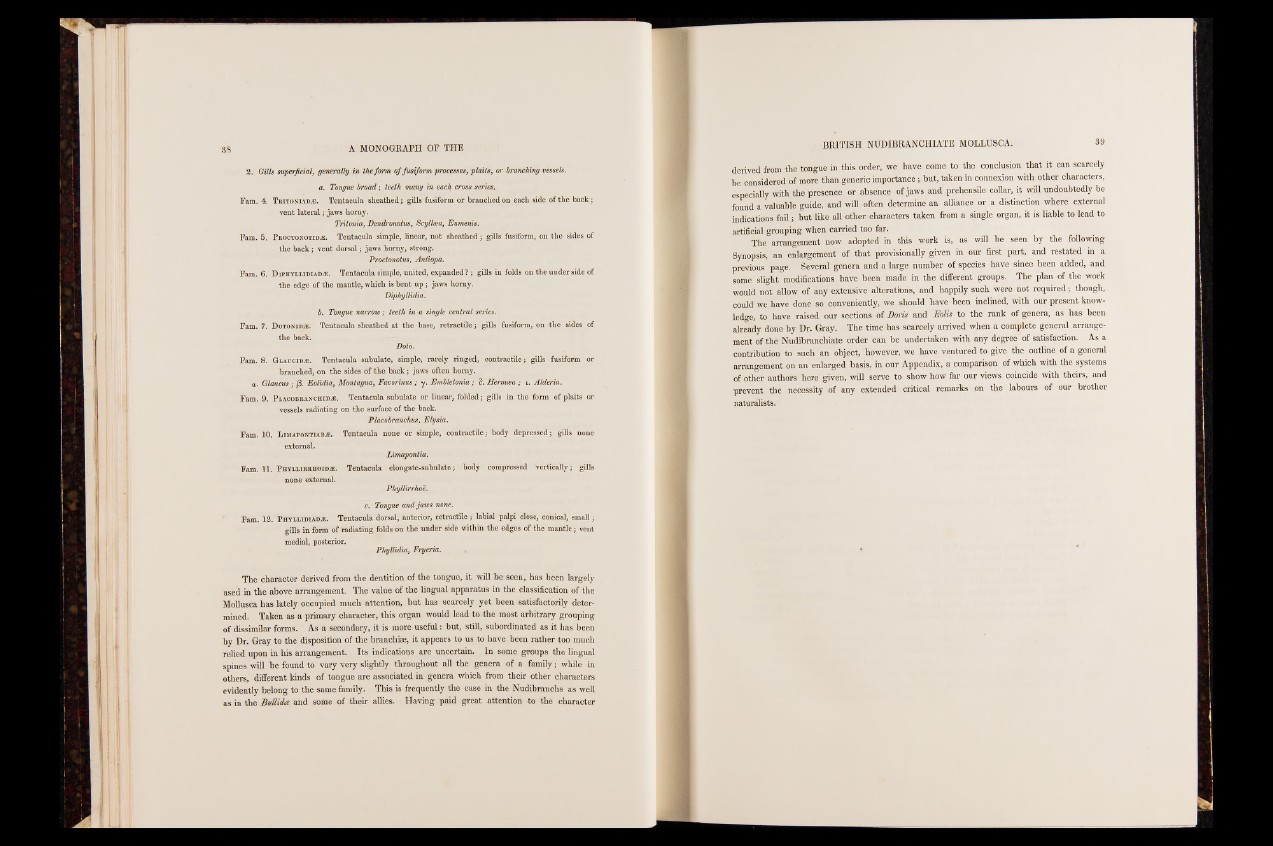
2. Gills superficial, generally in the form of fusiform processes, plaits, or branching vessels,
a. Tongue broad; teeth many in each cross series.
Fam. 4. Tritoniad^e . Tentacula sheathed; gills fusiform or branched on each side of the back;
vent lateral; jaws horny.
Tritonia, Dendronotus, Scylkea, Eumenis.
Fam. 5. P roctonotid2b. Tentacula simple, linear, not sheathed; gills fusiform, on the sides of
the back; vent dorsal; jaws horny, strong.
Proctonotus, Antiopa.
Fam. 6. D iphyllidiad^e. Tentacula simple, united, expanded ? ; gills in folds on the under side of
the edge of the mantle, which is bent u p ; jaws horny.
Diphyllidia.
b. Tongue narrow; teeth in a single central series.
Fam. 7. DoTONiniE. Tentacula sheathed at the base, retractile; gills fusiform, on the sides of
the back.
Doto.
Fam. 8. Glaucidæ. Tentacula subulate, simple, rarely ringed, contractile; gills fusiform or
branched, on the sides of the back ; jaws often horny,
a. Glaucus ; (3. Eolidia, Montagua, Favorinus ; y. Embletonia ; 8. Hermæa ; e. Alderia.
Fam. 9. P lacobranchid^e. Tentacula subulate or linear, folded; gills in the form of plaits or
vessels radiating on the surface of the back.
Placobranchus, Elysia.
Fam. 10. L imapontiad^ . Tentacula none or simple, contractile; body depressed; gills none
external.
Limapontia.
Fam. 11. P hyllirrhoidæ.
none external.
Tentacula elongate-subulate ; body compressed vertically ; gills
Phyllirrhoe.
c. Tongue and jaws none.
Tam. 12. Phyllidiad^ . Tentacula dorsal, anterior, retractile; labial palpi close, conical, small;
gills in form of radiating folds on the under side within the edges of the mantle; vent
medial, posterior.
PhyUidia, Pryeria. .
The character derived from the dentition of the tongue, it will be seen, has been largely
used in the above arrangement. The value of the lingual apparatus in the classification of the
Mollusca has lately occupied much attention, but has scarcely yet been satisfactorily determined.
Taken as a primary character, this organ would lead to the most arbitrary grouping
of dissimilar forms. As a secondary, it is more useful: but, still, subordinated as it has been
by Dr. Gray to the disposition of the branchiae, it appears to us to have been rather too much
relied upon in his arrangement. Its indications are uncertain. In some groups the lingual
spines will be found to vary very slightly throughout all the genera of a family; while in
others, different kinds of tongue are associated in genera which from their other characters
evidently belong to the same family. This is frequently the case in the Nudibranchs as well
as in the Bullidir. and some of their allies. Having paid great attention to the character
derived from the tongue in this order, we have come to the conclusion that it can scarcely
be considered of more than generic importance; but, taken in connexion with other characters,
especially with the presence or absence of jaws and prehensile collar, if will undoubtedly be
found a valuable guide, and will often determine an alliance or a distinction where external
indications fail; but like all other characters taken from a single organ, it is liable to lead to
artificial grouping when carried too far.
The arrangement now adopted in this work is, as will be seen by the following
Synopsis, an enlargement of that provisionally given in our first part, and restated in a
previous page. Several genera and a large number of species have since been added, and
some slight modifications have been made in the different groups. The plan of the work
would not allow of any extensive alterations, and happily such were not required; though,
could we have done so conveniently, we should have been inclined, with our present knowledge,
to have raised our sections of Doris and Eolis to the rank of genera, as has been
already done by Dr. Gray. The time has scarcely arrived when a complete general arrangement
of the Nudibranchiate order can be undertaken with any degree of satisfaction. As a
contribution to such an object, however, we have ventured to give the outline of a general
arrangement on an enlarged basis, in our Appendix, a comparison of which with the systems
of other authors here given, will serve to show how far our views coincide with theirs, and
prevent the necessity of any extended critical remarks on the labours of our brother
naturalists.